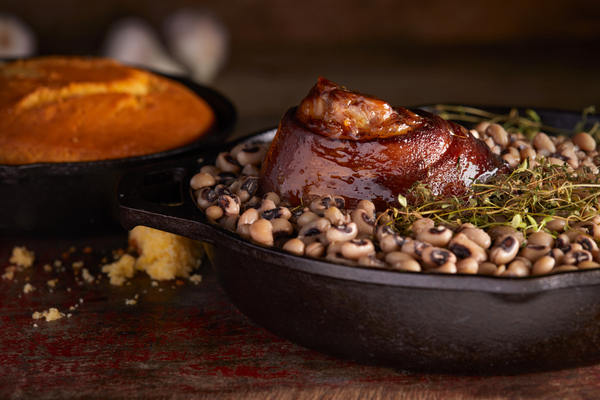Do you know why it’s good luck to eat black-eyed peas on New Year’s Day? As with most superstitions, there are several answers to the question. According to legendary Southern food researcher John Egerton’s Southern Food: At Home, On the Road, In History, black-eyed peas are associated with a “mystical and mythical power to bring good luck.”
Things traditionally served with the peas are ham, collard greens and cornbread. Why? Well, in many European cultures, pork is considered a sign of prosperity and progress. And, because pigs tend to be chunky, eating pork is supposed to pass on the trait of “chunkiness” to the person eating it — not chunky as in gaining weight, but chunky as in gaining cash. Also, did you know that pigs can’t see backwards? So pigs represent looking forward, and progress. As for the sides, collards are green (you know, like money), and the cornbread is golden in hue (yeah, like gold) and are thought to ensure you a financially prosperous new year. So it’s all about luck, prosperity, and making forward progress!
Now, back to the peas. There’s evidence that people ate black-eyed peas for luck as early as 500 A.D. as a part of the Jewish holiday Rosh Hashanah, the Jewish New Year. But the tradition of eating black-eyed peas with rice is African in origin and spread throughout the South, especially in the Carolinas, in the form of pilaus or rice dishes simmered for a long time with chicken or shrimp. When black-eyed peas were added to the pilau, it became Hoppin’ John.
Most Southerners will tell you that this culinary custom dates back to the Civil War. Black-eyed peas were considered animal food. The peas were not deemed worthy of serving to General Sherman’s Union troops. When Union soldiers raided the Confederates’ food supplies, legend says they took everything except the peas and salted pork. The Confederates considered themselves lucky to be left with those meager supplies, and survived the winter. Peas then became symbolic of luck.
Black-eyed peas were also given to enslaved people, as were most other traditional southern New Year’s foods and evolved through the years to be considered “soul food.” One variation of the superstition says that black-eyed peas were all the enslaved people in the South had to celebrate with on the first day of January 1863. What were they celebrating? That was the day when the Emancipation Proclamation went into effect. From then on, black-eyed peas were always eaten on the first day of January.
Others say that since farming has always been important in the South, black-eyed peas are available and are a good food to celebrate in the winter. Not many crops grow this time of the year, but black-eyed peas stored well, were cheap, and it all just made sense.
So, what’s the best way to eat the peas? Well, there are many traditions related to serving and eating black-eyed peas. Some people believe you should cook them with a new dime or penny, or add a coin to the pot before serving. The person who receives the coin in their portion will be extra lucky. If you serve peas with cornbread, it represents gold, and if they are stewed with tomatoes, it symbolizes wealth and health.
Some say you should eat exactly 365 peas on New Year’s Day. If you eat fewer, you’ll only be lucky for that many days (perhaps on leap years, you need to eat an extra one). However, if you eat any more than 365 peas, it turns those extra days into bad luck. Others say you should leave one pea on your plate, to share your luck with someone else (more of the humbleness that peas seem to represent). Yet others say if you don’t eat every pea on your plate, your luck will be bad. It’s also said that if you eat only peas, and skip the ham hocks, collard greens, and the accompaniments, the luck won’t stick. “They all work together or not at all.”
You can take all of these superstitions and dump them in one giant crock pot full of luck, or make up your own recipe on National Black-Eyed Peas day to celebrate!
—
Photo Credit: JD Spears / Shutterstock.com
